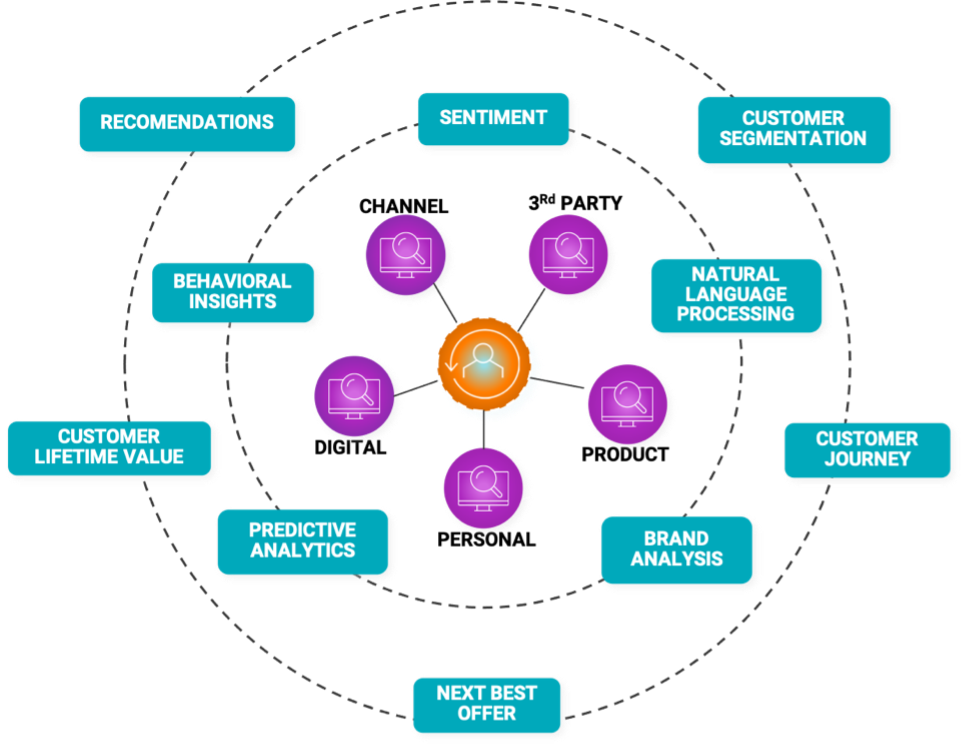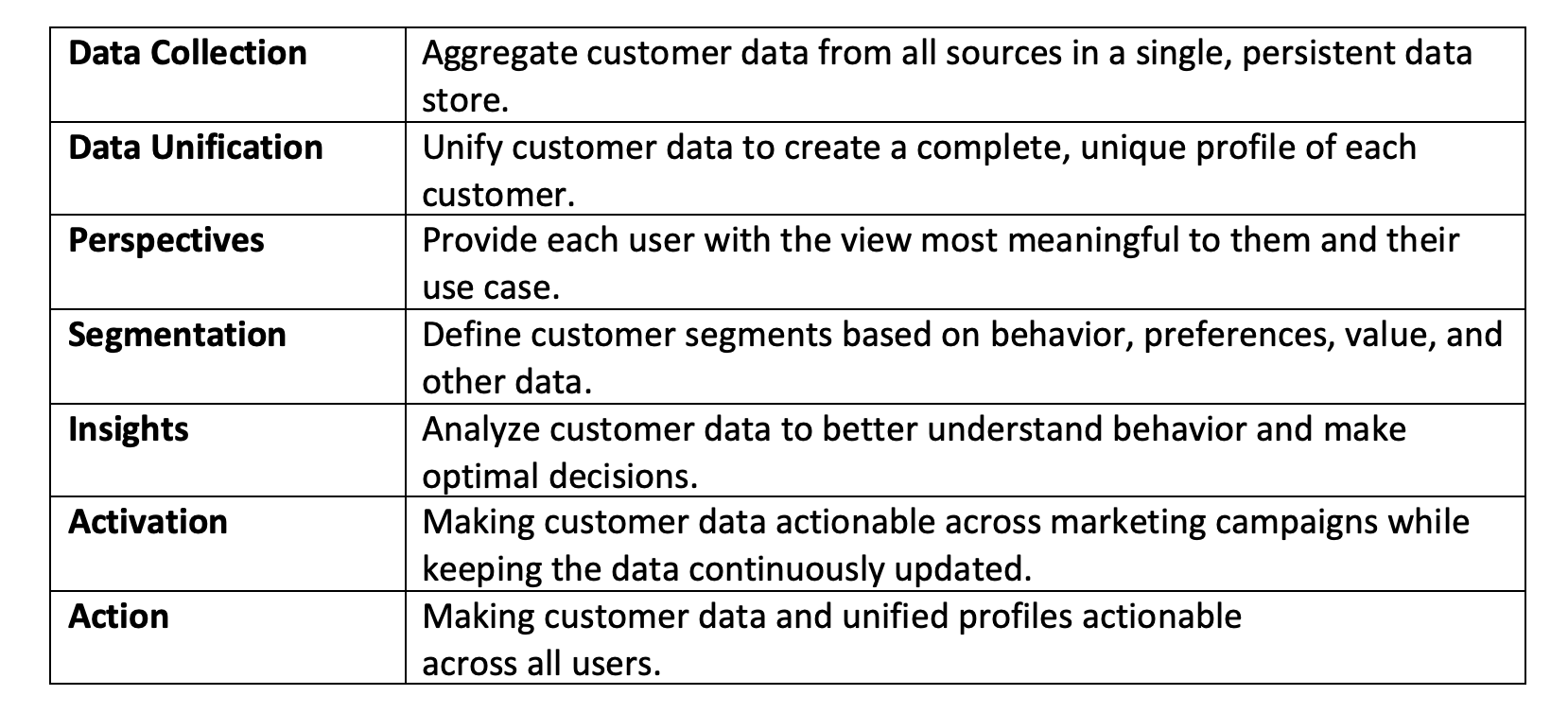Customer Data Platforms: Everything You Need to Know
Last Published: Aug 16, 2023 |

Data is the key to unlocking insights about your prospects, customers, guests, employees, patients, accounts, and so much more. By creating a connected view of all customer data, users across the business can make more informed decisions, be more proactive, and ultimately win the hearts and minds of customers.
A customer data platform (CDP) is a software solution that collects and unifies customer information, understands customer preferences, and organizes customers into segments. Traditional tools—which include customer relationship management (CRM) , data management platform (DMP), and data lakes—are designed to manage data but lack the functionality typically found in a customer data platform.
Selecting the right customer data platform starts with identifying which capabilities are required to address specific business needs and use cases. Consider the customer data platform’s ability to get data in and out of the system, automate via machine learning, perform analytics, provide reporting, and integrate with existing systems and applications.
A Shift in Customer Experience Expectations and Customer Data
There’s been significant disruption and change to customer behavior that many believe are permanent shifts as we navigate a post-pandemic world. It’s important to capture, understand, and capitalize on these shifts as we move into the new normal: What’s permanent? What’s temporary? How do companies evolve from today?
Customer experience (CX) is a very competitive battleground. Brands that want to stand apart in a crowded marketplace put customers at the center of their business emphasize the importance of meeting the increasingly high expectations of their customers. This is a key point, because customers today expect that the companies they do business with will understand who they are and interact with them accordingly. A great customer experience means the difference between a loyal customer and one who doesn’t hesitate to jump ship to a competitor.
By some estimates, we have vaulted ten years ahead in consumer and business digital penetration in less than three months.
21% of survey respondents said they switched to brands that sent them relevant messages or promotions in their preferred channel.
60% of global consumers changed shopping behavior and changed to new brands during the pandemic—many of them for value and convenience.
In order to deliver on the promise of customer experience, data must be clean, accurate, and accessible. However, this is not always the case in today’s digital world. Many organizations struggle with customer data that is scattered across channels, departments, and systems, creating silos of duplicate and fragmented data. Data quickly becomes outdated and inaccurate which can lead to poor marketing execution, mismatched efforts at personalization, and less-than-ideal experiences that may result in unintended churn and lost revenue.
To ensure every touchpoint with the customer hits the mark, you need to get a complete, connected, and trusted view of your customer data that is accessible to each and every user across the business. A customer data platform provides insights into your customers so you can build loyalty and deliver on expectations.
54% of companies say their biggest challenge to data-driven marketing success is the lack of data quality and completeness
What is a Customer Data Platform?
A customer data platform is a system, typically managed by marketing, that is capable of unifying customer data, whatever the source, and creating a single view of the customer. Customer data platforms also provide deep analytical insights that are easy for non-technical people to understand and orchestrate data for action across channels. For organizations trying to create personalized customer experiences, CDPs organize and enable analysis of all the data required in order to optimize the timing and targeting of messages and offers.
With a single source of truth based on detailed and illuminating customer insights, you can optimize your marketing operations. Customer data platforms are typically used to identify digital contacts, move prospects from anonymous to known, campaign segmentation, and personalization. In addition, some customer data platforms support analytics including fraud analytics, anti-money laundering (AML) and relationship discovery.
Typical data elements managed by a customer data platform may include:
- Demographics (individual name, address, DOB etc.)
- Firmographics (organization name, size, industry etc.)
- Geography
- Device preference
- Channel preference
- Purchase history
- Most recent browsing and/or email behavior
- Customer service history
- Lifetime value
- Propensity to engage
- Likelihood to buy
- Next best product recommendations
- Next best channel
- Likelihood to churn

Benefits of a customer data platform
Implementing a customer data platform to help organize and streamline data from all available sources will have a direct impact to your business. Customer data platforms help marketers, sales teams, and customer support/service reps improve execution by serving up better data and deeper insights about customers. Ultimately, organizations who invest in a customer data platform can deliver on their customer-centricity vision and customer experience goals.
Benefit #1 – Gain more customers
A customer data platform helps to grow market share by connecting information to ensure the right prospects are being targeted at the right time through the right channel. With a contextual view of customer data, marketers can tailor offers that improve customer acquisition rates at a lower cost. Campaigns based on micro-targeted segments perform better and result in improved lead generation and conversion rates.
In the last six years, the cost of acquiring new customers has increased 60%.
Benefit #2: Retain the right customers
With a better view of each individual customer or account, organizations can do more than just sell a product or service. They can build relationships that result in repeat business. A customer data platform helps to increase customer lifetime value and profitability (share of wallet) while reducing churn. A happy customer is a loyal customer.
It costs five times as much to attract a new customer than to keep an existing one
Benefit #3: Optimize customer experiences
As we have said, data is key to creating brilliant customer experiences. Customer data platforms can identify next best action or offer or even understand when to NOT engage with a customer due to an open service request or unresolved issue. Being able to personalize interactions results in improved customer satisfaction, retention, and loyalty.
Consumers are willing to pay 16% more for products and services from brands that provide an excellent customer experience.
Key Capabilities of a Customer Data Platforms
Depending on the software vendor’s history and area of expertise, customer data platforms may focus more on managing data or more on analyzing the data, however, most customer data platforms provide a core set of capabilities across data management, analytics and marketing enablement.
Typical customer data platform capabilities include:

Digital transformation has spawned new channels and data types, making the process of managing customer data more critical and complex. Some customer data platforms incorporate artificial intelligence (AI) and machine learning (ML) to automate processes such as matching of customer profiles as well as analytics to uncover insights hiding in data.
As data volumes reach into the billions of records due to digital interactions across mobile devices and online transactions, it is no longer feasible for humans to identify all duplicate records or find patterns and trends in data. ML can help automate and reduce manual efforts, resulting in cost savings and increased accuracy of customer profiles.
Insights provide deeper understanding of customers so you can better tailor marketing messages, personalize interactions, predict next best offer, and understand channel preference. Marketing, sales, service and support will all be armed with better data and insights that improve efficiency and overall customer experience.
Not all customer data platforms are created equal, so understanding what capabilities are available will help in selecting the right tool to meet your needs.
Customer data platforms differ from other data management solutions
With a number of customer data management solutions on the market, it is important to know the differences and recognize overlapping capabilities.
Customer Data Platform
A customer data platform is designed to make customer data and insights available to marketing technology (MarTech) and advertising technology applications (AdTech). Data managed may include known (customers) and unknown (prospects). Marketing teams as well as sales, support and service are common users of a customer data platform.
Master Data Management
Master Data Management (MDM) is designed to manage enterprise data, data which is shared by the users of an organization, generally across departments and/or geographic regions. MDM’s goal is to make a golden record of master data available for enterprise and business applications. Users include data stewards and business functions.
Data Lake
A data lake is a storage repository that holds a vast amount of raw data in its native format until it is needed. It is typically a landing place to make enterprise data available for analysis and future usage.
Data Management Platform (DMP)
A data management platform (DMP) is a unifying platform to collect, organize and activate first-, second-, and third-party audience data from sources including online, offline, and mobile. A DMP manages segments of anonymous customers and makes them available to MarTech and AdTech applications.
Selecting the right customer data platform for your business
In a sea of overlapping options, it is important to choose the right customer data platform based on your business needs. Answer these questions to select the right customer data platform for you.
- Data. Does the customer data platform help with cleaning, deduplicating, merging, and validating contact data information such as names, email addresses, phone numbers, and mailing addresses for customer data management to ensure enriched, high-quality data?
- Identity Resolution. Is the customer data platform able to resolve, persist, and manage unique customer identities and maintain a consistent view of the customer with AI-powered matching algorithms to handle the scale of customer data and digital transformation?
- Integration. Can the customer data platform get data in/out of the system in real time and batch and ensure seamless interoperability with source systems and consuming applications and systems, both internal and external?
- Performance. Is the customer data platform designed to scale with ease as data volumes and varieties and number of users grow?
Get started with customer data platforms
To help get you started on you customer data platform journey, Informatica has compiled a list of over 100 RFP questions. These questions are indented to help you identify the capabilities and features that best align to your business use cases and objectives. Download the “Building the Ideal Customer Data Platform RFP” white paper and accompanying checklist to get started on your journey to better customer data.








